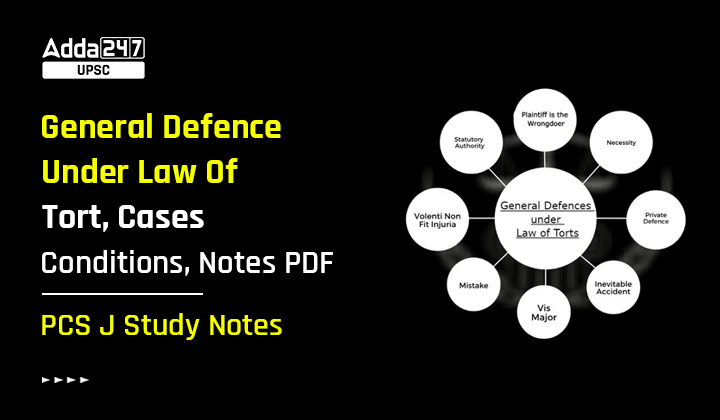Table of Contents
General Defence Under Law Of Tort: The law of torts is a branch of civil law that deals with the civil wrongs committed by one person against another person. In simple words, tort law provides remedies to those who have suffered harm or loss due to the actions or omissions of another person. However, there are certain situations where the defendant may be able to avoid liability even if they have committed a tort. These situations are known as general defence under law of tort.
General Defences under Law of Torts: An Overview
There are various types of general defence under law of tort available, but in this article, we will focus on the general defences that can be raised in any tort action. These defences are based on the principle that the defendant should not be held liable for something that they had no control over or where their actions were justified in some way. A defendant may use various general defence under law of tort to avoid liability for the plaintiff’s injuries or damages. Some of the general defence under law of tort have been discussed in detail in this article.
Volenti non fit injuria (Consent)
One of the most common general defence under law of tort is the doctrine of volenti non fit injuria, which means that no injury is done to a person who consents to it. This general defence under law of tort is based on the principle that if a person voluntarily agrees to assume a risk or waive their rights, they cannot later claim compensation for any harm or loss that results from that action.
For example, in the case of Smith v. Baker & Sons [1891] AC 325, the plaintiff was a soldier who had been injured during a military training exercise. The plaintiff argued that the defendants were negligent in failing to provide him with adequate safety equipment. However, the court held that the plaintiff had consented to the risk of injury by participating in the exercise and therefore could not claim compensation.
Necessity
Another general defence under law of tort is the defence of necessity. This general defence under law of tort is based on the principle that a person can be excused for committing a tort if it was done out of necessity to prevent greater harm.
For example, in the case of Southport Corporation v. Esso Petroleum Co Ltd [1953] 2 QB 182, the defendant had parked a petrol tanker in a busy town centre. The town council ordered the defendant to move the tanker, but the defendant refused, arguing that the only alternative was to leave the tanker unattended on a steep hill, which would have posed a greater risk to public safety. The court held that the defendant’s actions were necessary to prevent greater harm, and therefore the defence of necessity applied.
Self-Defence
The general defence under law of tort of self-defence is also available under the law of torts. This defence allows a person to use reasonable force to defend themselves or their property from a perceived threat.
For example, in the case of Bird v. Holbrook (1828) 4 Bing 628, the defendant had set a spring gun in his garden to protect his property from intruders. The plaintiff, who was unaware of the trap, entered the garden and triggered the spring gun, causing him injury. The court held that the defendant was entitled to use reasonable force to protect his property, but he had a duty to give adequate warning to prevent injury to others.
Contributory Negligence
Contributory negligence is another general defence under law of tort, which allows the defendant to argue that the plaintiff’s own negligence contributed to the harm they suffered.
For example, in the case of Froom v. Butcher [1976] QB 286, the plaintiff was injured in a car accident caused by the defendant’s negligence. However, the court held that the plaintiff had also contributed to their own injury by failing to wear a seatbelt. The court reduced the amount of damages awarded to the plaintiff to reflect their own negligence.
Statutory Authority
The Statutory Authority general defence under law of tort allows defendants to escape liability for harm caused to the plaintiff if they can prove that they were acting in accordance with a statutory duty or power conferred upon them by a valid and applicable statute.
To successfully rely on the Statutory Authority general defence under law of tort, the defendant must demonstrate that:
- There was a statutory duty or power that required or authorized them to act in the manner that caused the harm to the plaintiff; and
- They were acting within the scope of their statutory duty or power when they caused the harm.
The defense has been successfully invoked in numerous cases, including Hill v Chief Constable of West Yorkshire, where the police were held not liable for failing to apprehend the Yorkshire Ripper earlier.
Inevitable Accident
Importance of General Defences
Judiciary Related Links:
Uttarakhand Judiciary Syllabus 2023
Uttarakhand Judiciary Previous Year Question Papers
Juvenile Justice System in India



 TSPSC Group 1 Question Paper 2024, Downl...
TSPSC Group 1 Question Paper 2024, Downl...
 TSPSC Group 1 Answer key 2024 Out, Downl...
TSPSC Group 1 Answer key 2024 Out, Downl...
 UPSC Prelims 2024 Question Paper, Downlo...
UPSC Prelims 2024 Question Paper, Downlo...





